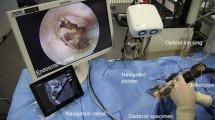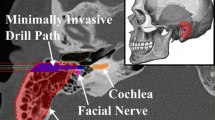Abstract
Purpose We developed a surgical navigation system that warns the surgeon with auditory and visual feedback to protect the facial nerve with real-time monitoring of the safe region during drilling.
Methods Warning navigation modules were developed and integrated into a free open source software platform. To obtain high registration accuracy, we used a high-precision laser-sintered template of the patient’s bone surface to register the computed tomography (CT) images. We calculated the closest distance between the drill tip and the surface of the facial nerve during drilling. When the drill tip entered the safe regions, the navigation system provided an auditory and visual signal which differed in each safe region. To evaluate the effectiveness of the system, we performed phantom experiments for maintaining a given safe margin from the facial nerve when drilling bone models, with and without the navigation system. The error of the safe margin was measured on postoperative CT images. In real surgery, we evaluated the feasibility of the system in comparison with conventional facial nerve monitoring.
Results The navigation accuracy was submillimeter for the target registration error. In the phantom study, the task with navigation (\(0.7 \pm 0.25\) mm) was more successful with smaller error, than the task without navigation (\(1.37 \pm 0.39\) mm, \(P<0.05\)). The clinical feasibility of the system was confirmed in three real surgeries.
Conclusions This system could assist surgeons in preserving the facial nerve and potentially contribute to enhanced patient safety in the surgery.












Similar content being viewed by others
References
Labadie RF, Shah RJ, Harris SS, Cetinkaya E, Haynes DS, Fenlon MR, Juszczyk AS, Galloway RL, Fitzpatrick JM (2005) In vitro assessment of image-guided otologic surgery: submillimeter accuracy within the region of the temporal bone. Otolaryngol Head Neck Surg 132:435–442
Strauss G, Koulechov K, Hofer M, Dittrich E, Grunert R, Moeckel H, Muller E, Korb W, Trantakis C, Schulz T, Meixensberger J, Dietz A, Lueth T (2007) The navigation-controlled drill in temporal bone surgery: a feasibility study. Laryngoscope 117:434–441
Green JD Jr, Shelton C, Brackmann DE (1994) Iatrogenic facial nerve injury during otologic surgery. Laryngoscope 104:922–926
Caversaccio M, Bachler R, Ladrach K, Schroth G, Nolte LP, Hausler R (2000) Frameless computer-aided surgery system for revision endoscopic sinus surgery. Otolaryngol Head Neck Surg 122:808–813
Zbräen P, Tschumi I, Nuyens M, Stauffer E (2005) Recurrent pleomorphic adenoma of the parotid gland. Am J Surg 189:203–207
Caversaccio M, Freysinger W (2003) Computer assistance for intraoperative navigation in ENT surgery. Minim Invasive Ther Allied Technol 12:36–51
Ewers R, Schicho K, Undt G, Wanschitz F, Truppe M, Seemann R, Wagner A (2005) Basic research and 12 years of clinical experience in computer-assisted navigation technology: a review. Int J Oral Maxillofac Surg 34:1–8
Strauss G, Koulechov K, Rottger S, Bahner J, Trantakis C, Hofer M, Korb W, Burgert O, Meixensberger J, Manzey D, Dietz A, Luth T (2006) Evaluation of a navigation system for ENT with surgical efficiency criteria. Laryngoscope 116:564–572
Herbert S, White DW (1991) Continuous electrical stimulation as a helpful adjunct during intraoperative facial nerve monitoring. Skull base Surg 1:127–131
Silverstein H, Smouha EE, Jones R (1988) Routine intraoperative facial nerve monitoring during otologic surgery. Am J Otol 9:269–275
Noss RS, Lalwani AK, Yingling CD (2001) Facial nerve monitoring in middle ear and mastoid surgery. Laryngoscope 111:831–836
Wegner CM, Carron DB (2000) Surgical navigation system and method using audio feedback. US Patent 6,083,163, issued July 4
Voormolen EH, van Stralen M, Woerdeman PA, Pluim JP, Noordmans HJ, Viergever MA, Regli L (2012) Determination of a facial nerve safety zone for navigated temporal bone surgery. Neurosurgery 70(50–60):R12
Voormolen EH, Woerdeman PA, van Stralen M, Noordmans HJ, Viergever MA, Regli L (2012) Validation of exposure visualization and audible distance emission for navigated temporal bone drilling in phantoms. PLoS One 7:e41262
Tokuda J, Fischer GS, Papademetris X, Yaniv Z, Ibáñez L, Cheng P, Liu H, Blevins J, Arata J, Golby AJ, Kapur T, Pieper S, Burdette EC, Fichtinger G, Tempany CM, Hata N (2009) OpenIGTLink: an open network protocol for image-guided therapy environment. Int J Med Robot 5(4):423–434
Hong J, Matsumoto N, Ouchida R, Komune S, Hashizume M (2009) Medical navigation system for otologic surgery based on hybrid registration and virtual intraoperative computed tomography. IEEE Trans Biomed Eng 56:426–432
Matsumoto N, Hong J, Hashizume M, Komune S (2009) A minimally invasive registration method using surface template-assisted marker positioning (STAMP) for image-guided otologic surgery. Otolaryng Head Neck Surg 140:96–102
Oka M, Cho B, Matsumoto N, Hong J, Komune S, Hashizume M (2011) Pre-registered STAMP method for instant registration in image-guided temporal bone surgery. In: Proceedings of Comp Assist Radiol Surg (CARS). Berlin, Germany, pp 123–124
Hong J, Hashizume M (2010) An effective point-based registration tool for surgical navigation. Surg Endosc 24:944–948
Hubbard PM (1995) Collision detection for interactive graphics applications. IEEE Trans Vis Comput Graph 1:218–230
Hubbard PM (1993) Interactive collision detection. In: Proceedings of IEEE, 1993 symposium on research frontiers in virtual reality. USA, San Jose, pp 24–31
Bernardeschi D, Meskine N, Otaibi NA, Ablonczy R, Kalamarides M, Grayeli AB, Sterkers O (2011) Continuous facial nerve stimulating burr for otologic surgeries. Otol Neurotol 32:1347–1351
Georg E, Joachim M (2007) Template-based registration for image-guided skull base surgery. Otolaryngol Head Neck Surg 136:907–913
Luebbers HT, Messmer P, Obwegeser JA, Zwahlen RA, Kikinis R, Graetz KW, Matthews F (2008) Comparison of different registration methods for surgical navigation in cranio-maxillofacial surgery. J Craniomaxillofac Surg 36:109–116
Bettschart C, Kruse A, Matthews F, Zemann W, Obwegeser JA, Grätz KW, Lübbers HT (2011) Point-to-point registration with mandibulo-maxillary splint in open and closed jaw position. Evaluation of registration accuracy for computer-aided surgery of the mandible. J Craniomaxillofac Surg 40:592–598
Ralph AN (1982) Temporal bone surgical dissection manual. House Ear Institute, Los Angeles
Duckworth EA, Silva FE, Chandler JP, Batjer HH, Zhao JC (2008) Temporal bone dissection for neurosurgery residents: identifying the essential concepts and fundamental techniques for success. Surg Neurol 69:93–98
Acknowledgments
This work was supported in part by the Innovation Center for Medical Redox Navigation at Kyushu University, Japan. Jaesung Hong was partly supported by Korea government with the grants of MIREBrain and Convergence Science Center (12-BD-0402) of DGIST.
Conflict of interest
We certify that there is no real or potential conflict of interest in relation to this article.
Author information
Authors and Affiliations
Corresponding author
Electronic supplementary material
Below is the link to the electronic supplementary material.
Rights and permissions
About this article
Cite this article
Cho, B., Oka, M., Matsumoto, N. et al. Warning navigation system using real-time safe region monitoring for otologic surgery. Int J CARS 8, 395–405 (2013). https://doi.org/10.1007/s11548-012-0797-z
Received:
Accepted:
Published:
Issue Date:
DOI: https://doi.org/10.1007/s11548-012-0797-z




